Abstract
Some polynuclear aromatics (PNA) have been found to be potent carcinogens for all tissues and organs of experimental animals that have been exposed to them, but different dose levels are needed for these effects. They have been known for decades to cause cancer at the site of application but also at certain sites distant from the area of contact. Although some hydrocarbons are potent and complete carcinogens, the majority of related hydrocarbons was originally found to be inactive. Since they generally appear together, it was important to know more about their interaction, particularly whether they would synergize, or antagonize. The polycyclic hydrocarbons have been studied by subcutaneous injection, where they prove very potent carcinogens. They are also very active on the skin of mice where they produce cancer on prolonged application. Inhalation studies, require larger doses yielded negative results until particulate matter was introduced which facilitated the development of lung tumors. Although iron oxide dust was used initially, other dusts were also capable of enhancing the response of the tissue to benzo(a)pyrene carcinogenesis. This point is of importance, particularly since the inhalation of PNA in situations of air pollution or coal mining involves particulates, although of a different type. Soot is not a homogenous substance and several factors determine its properties. Soots will lose some of the absorbed chemicals during their residence in air, but they retain their PNAs for long periods of time when they reach the soil. The carcinogenicity of PNAs in the adsorbed state may be completely absent, depending on particle size of the soot and availability of eluting capability of the tissues or cells in contact with the soot. Whenever the carcinogenic polynuclear aromatics can be eluted they will be active in producing cancer if their residence is adequate. There seems to be no reason to assume that a large increase in coal combustion in the future will by necessity lead to greater risks of cancer to the coal miners or the general urban dweller, because activities to be started now can take into consideration the requirements necessary for control of air pollution in mines as well as in cities. If new uses of coal will be developed, it will be a completely different situation, and statements about the carcinogenic risk from coal utilization do not apply there. Although some of the same carcinogenic PNAs are involved in the health hazards from those processes, other carcinogens and also cocarcinogens will be present, and the exposed workers will not have the apparent benefits of adsorption of PNAs on soot.
Full text
PDF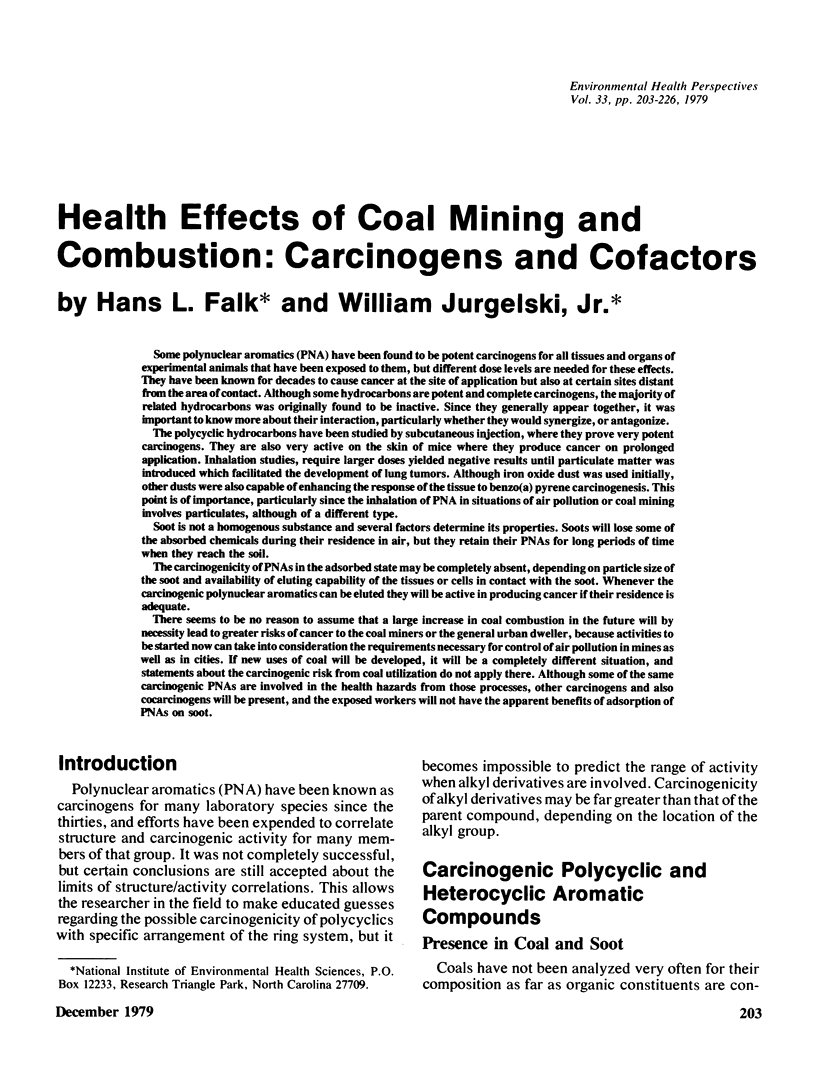
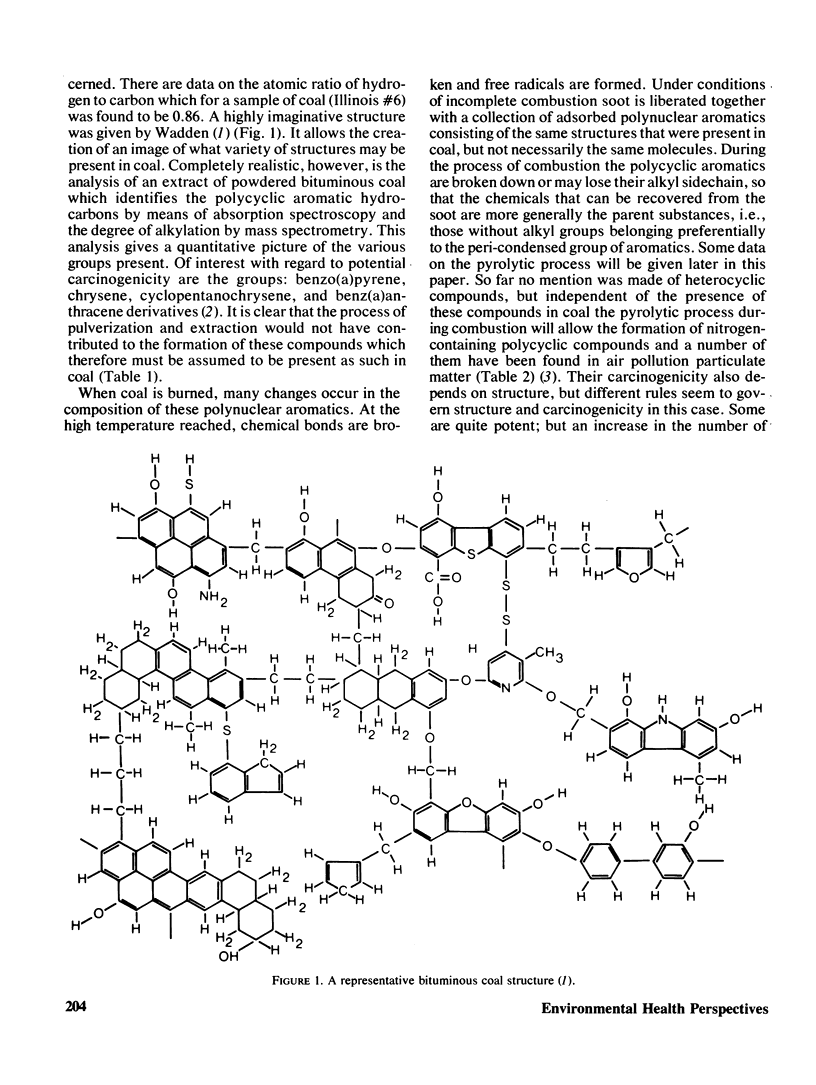
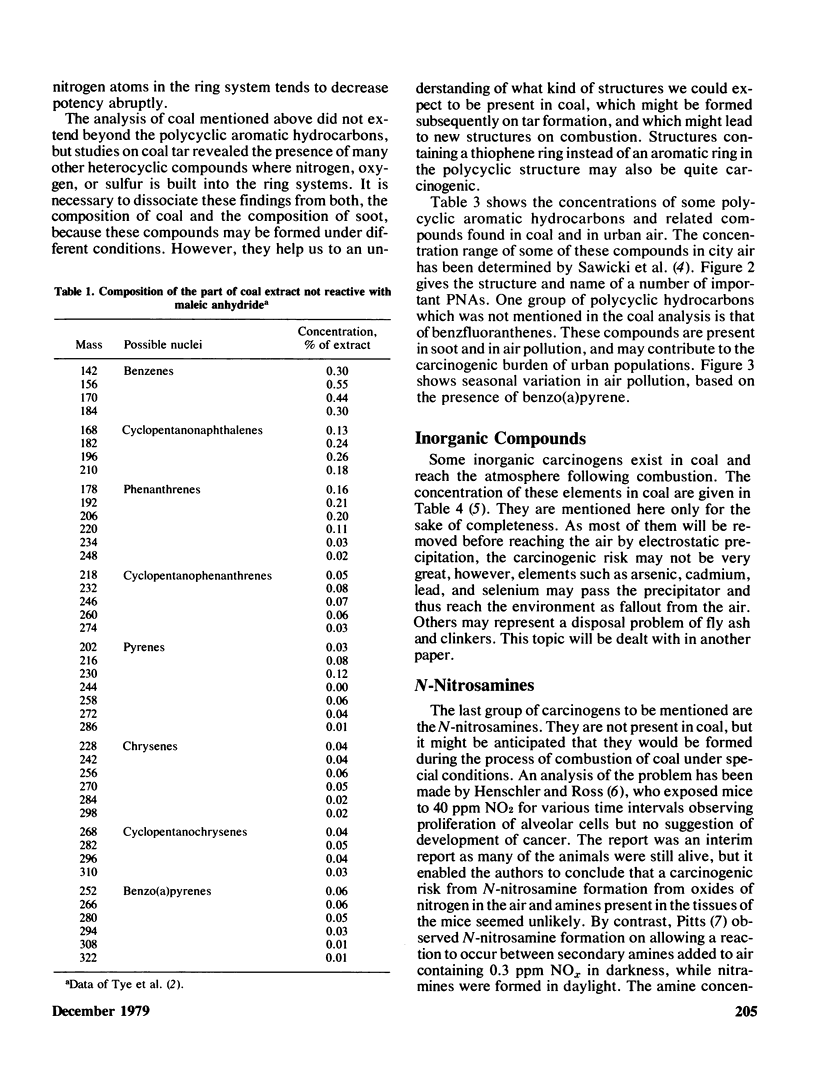

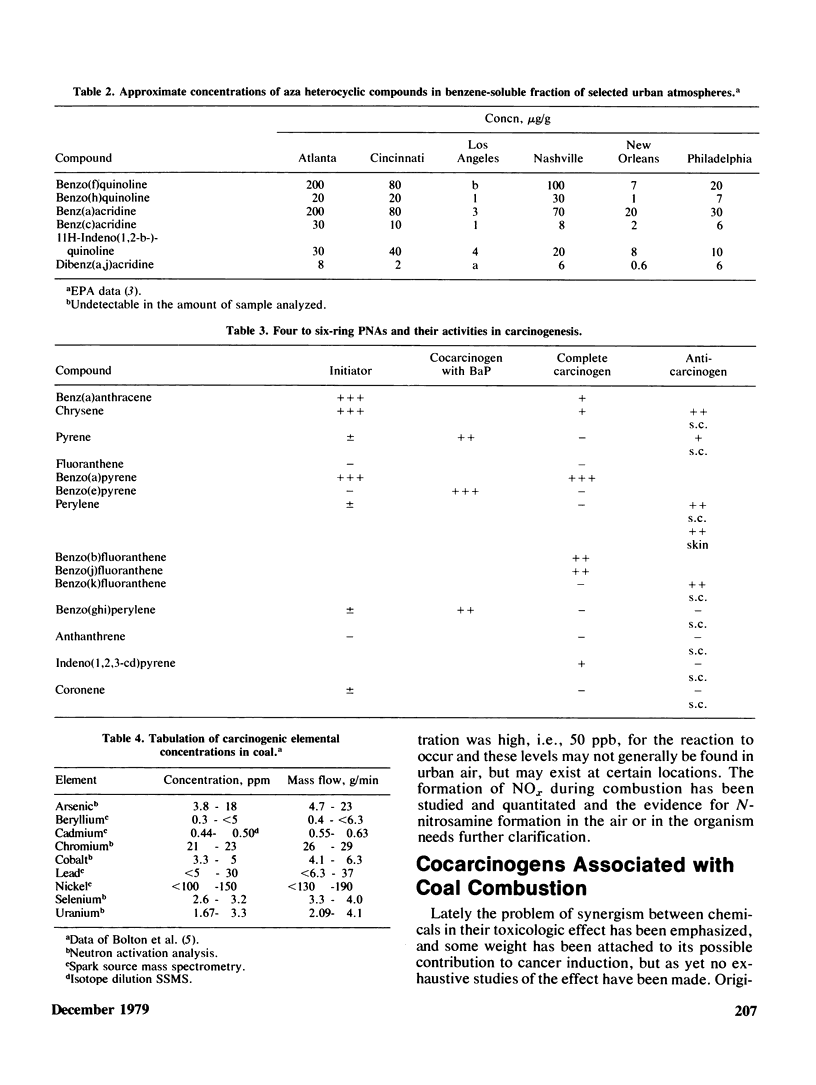
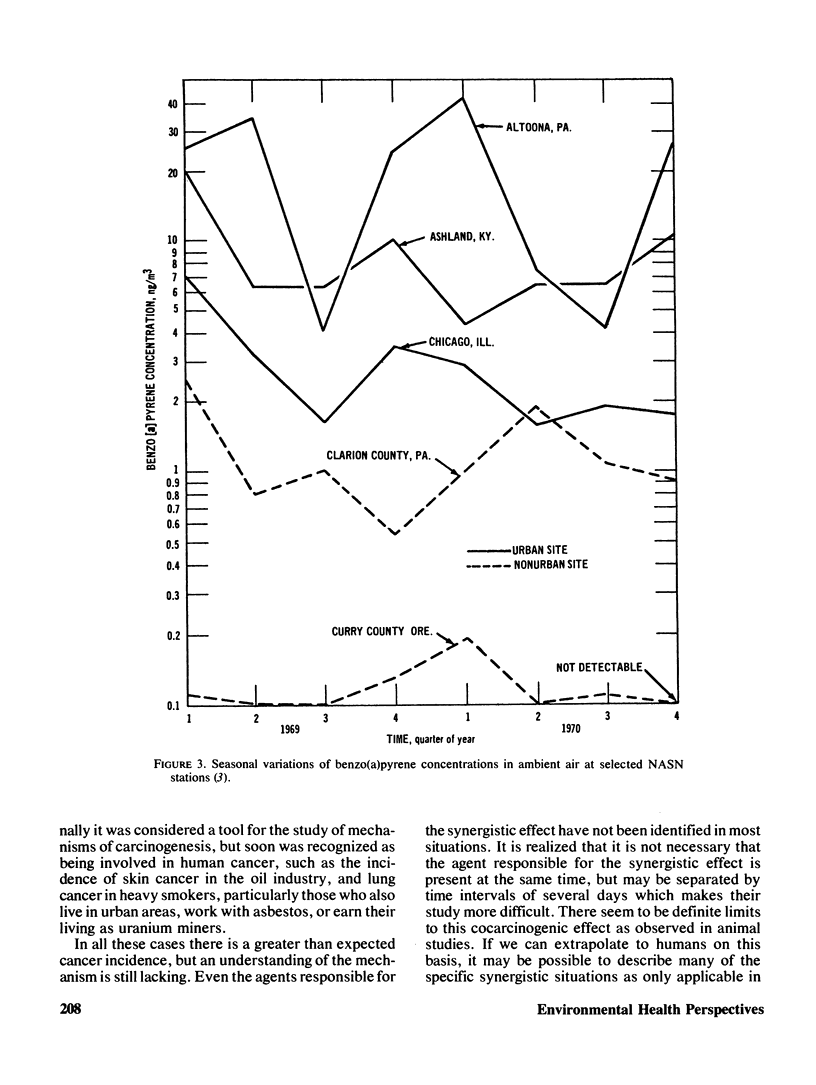
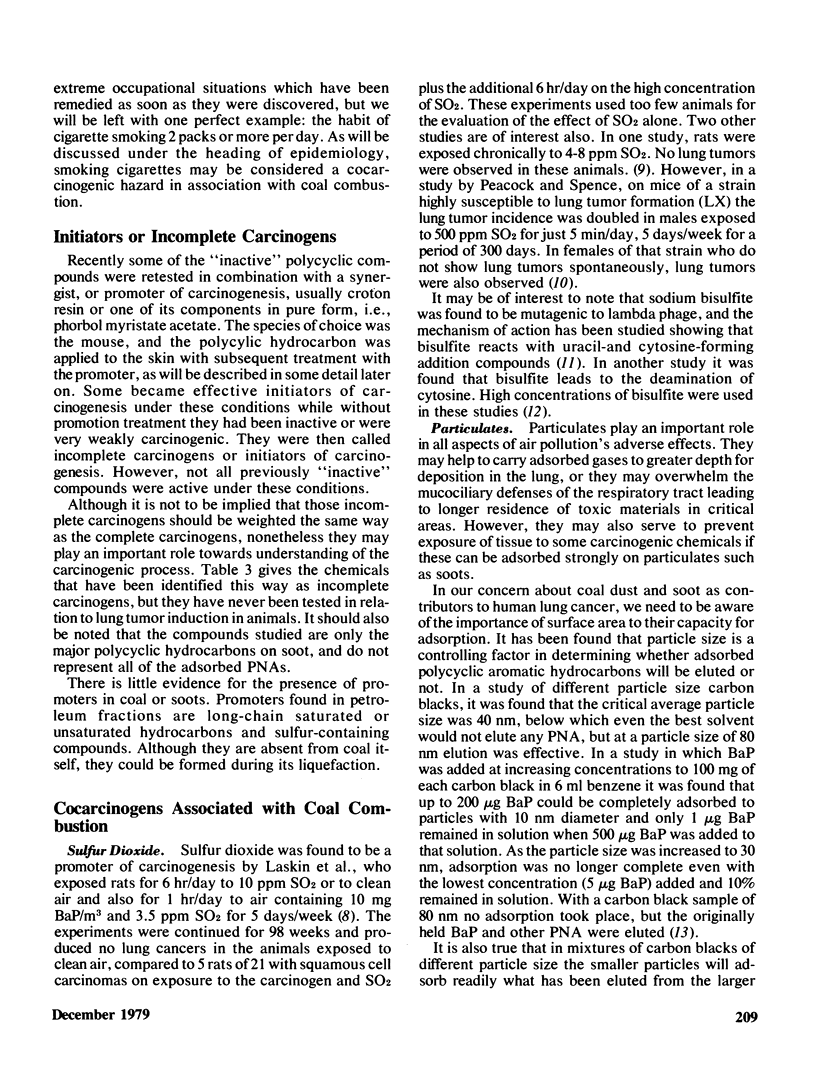
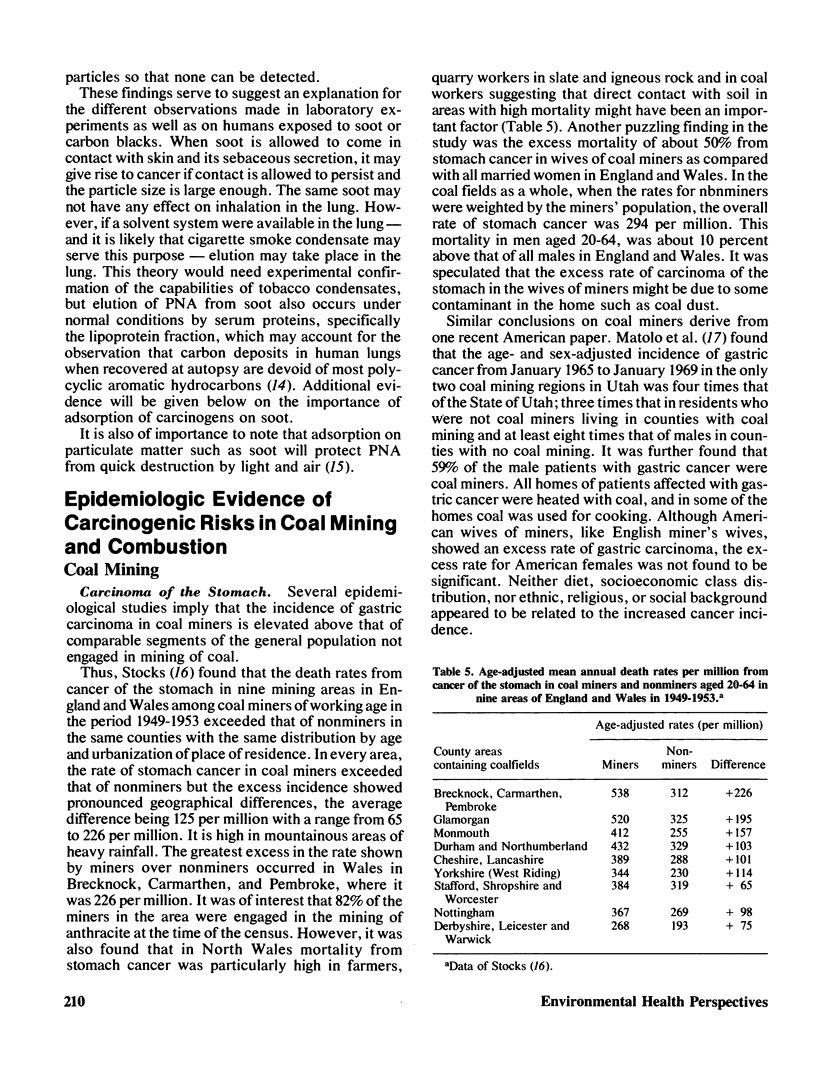
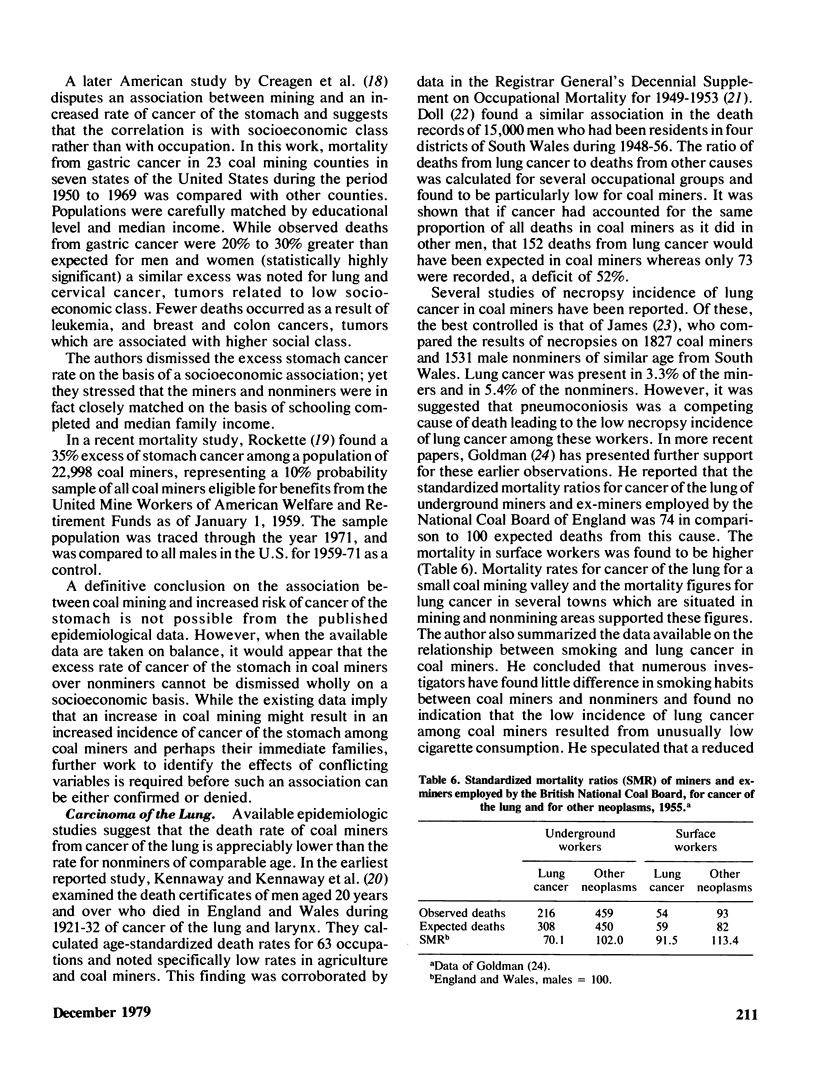
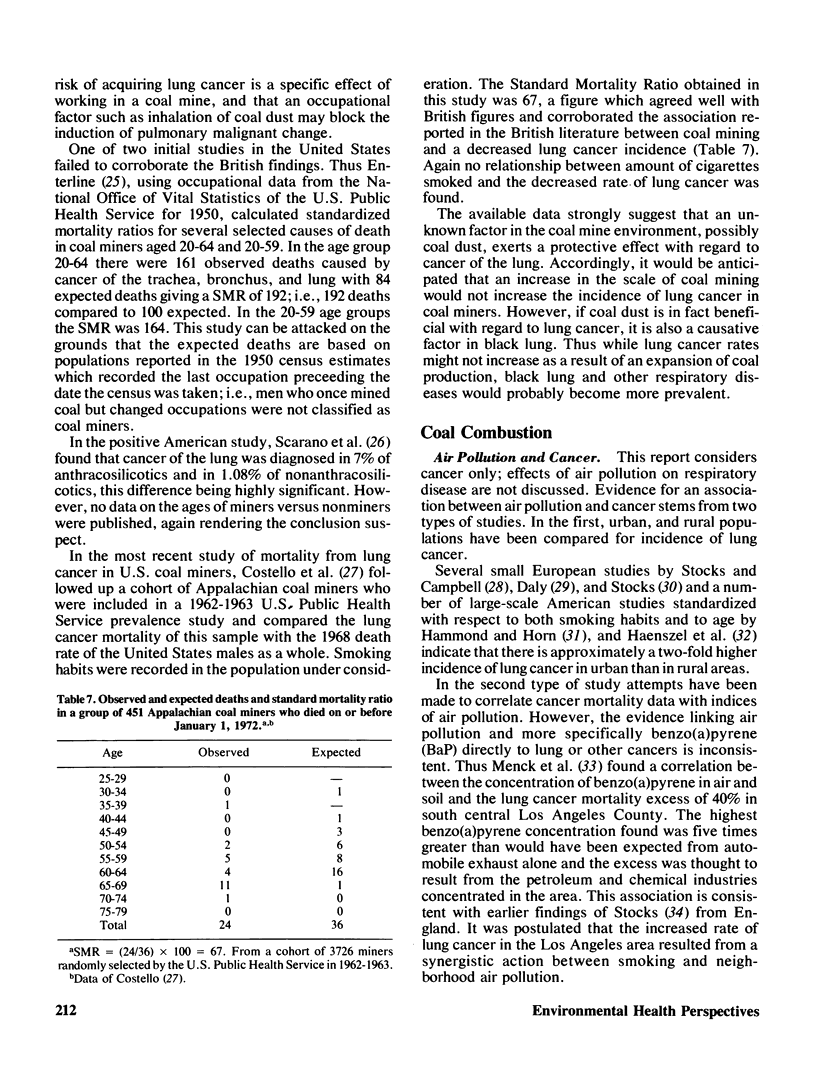
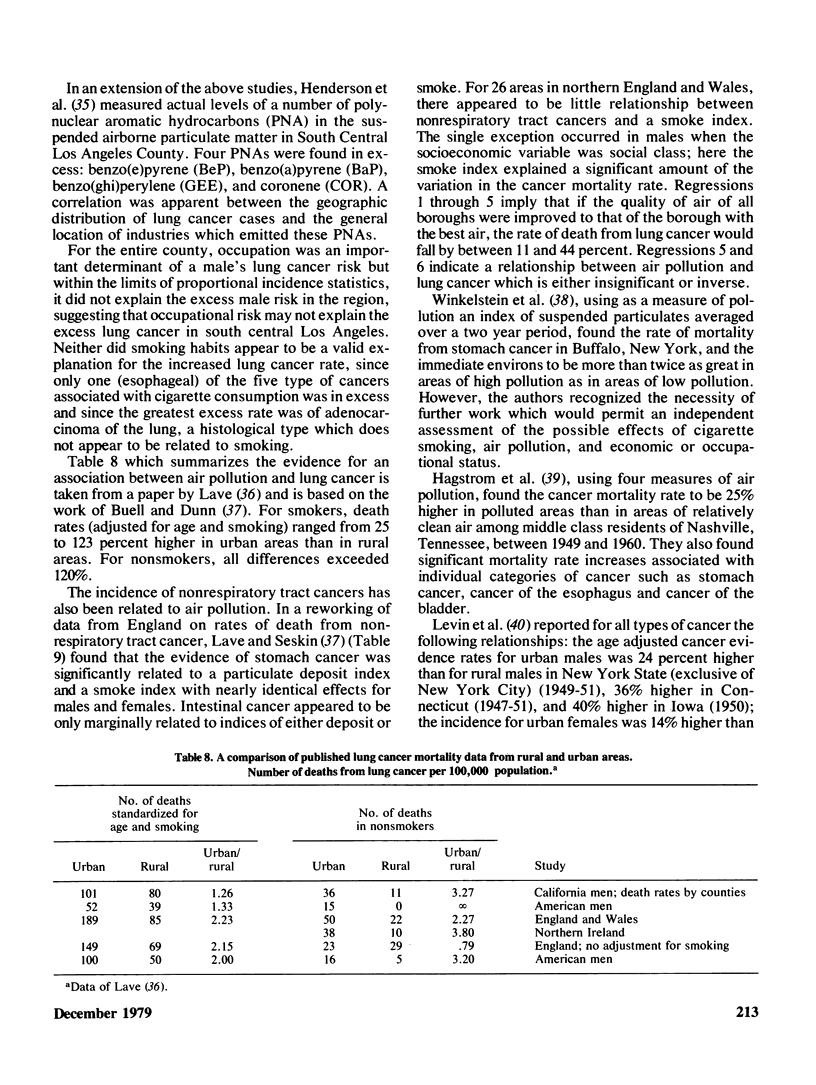
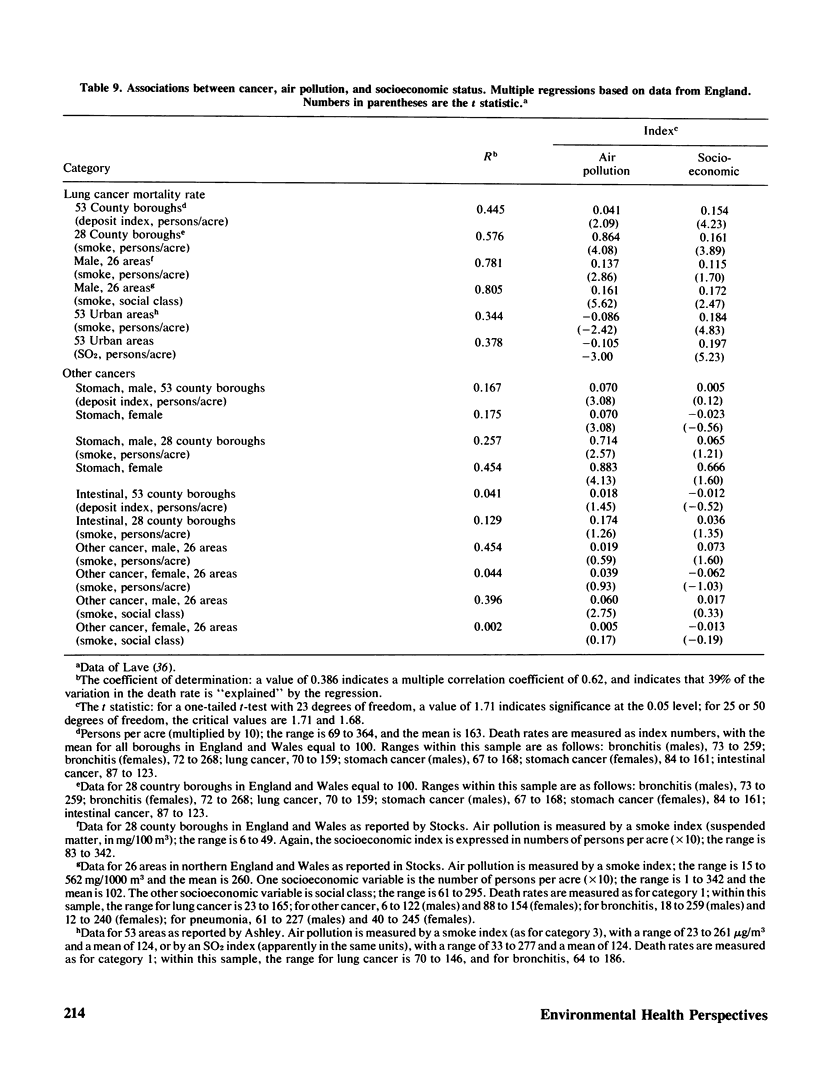
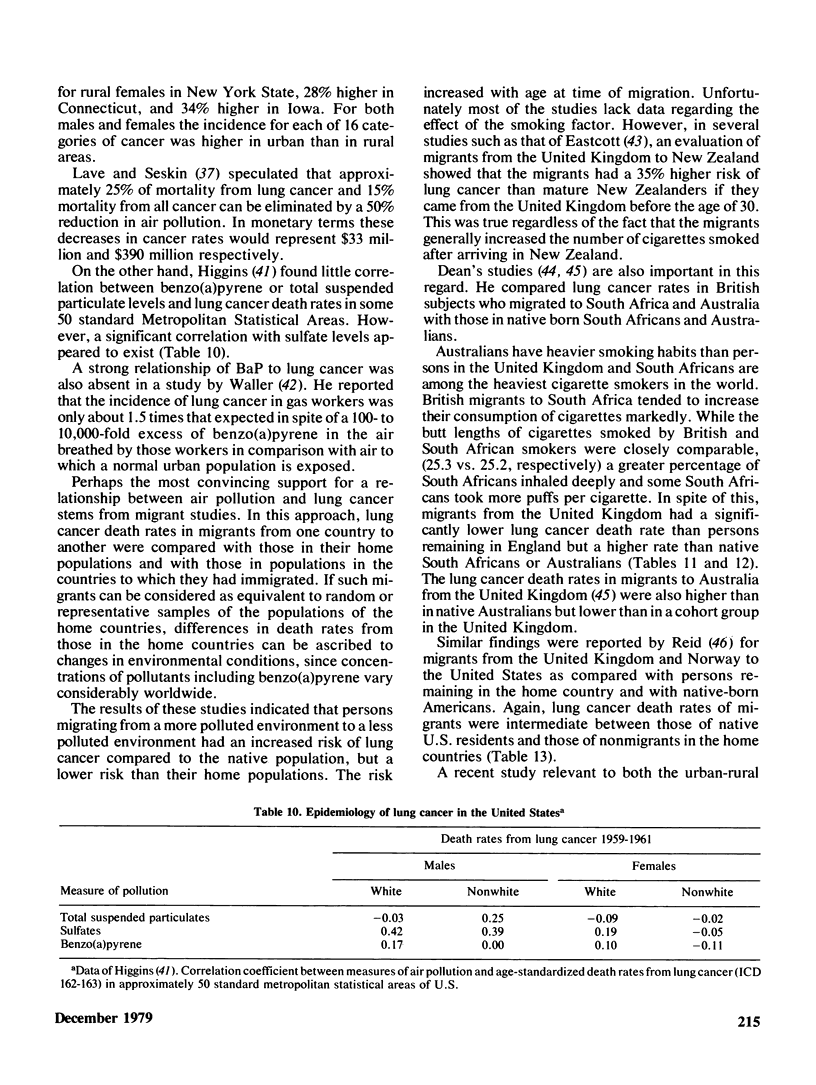
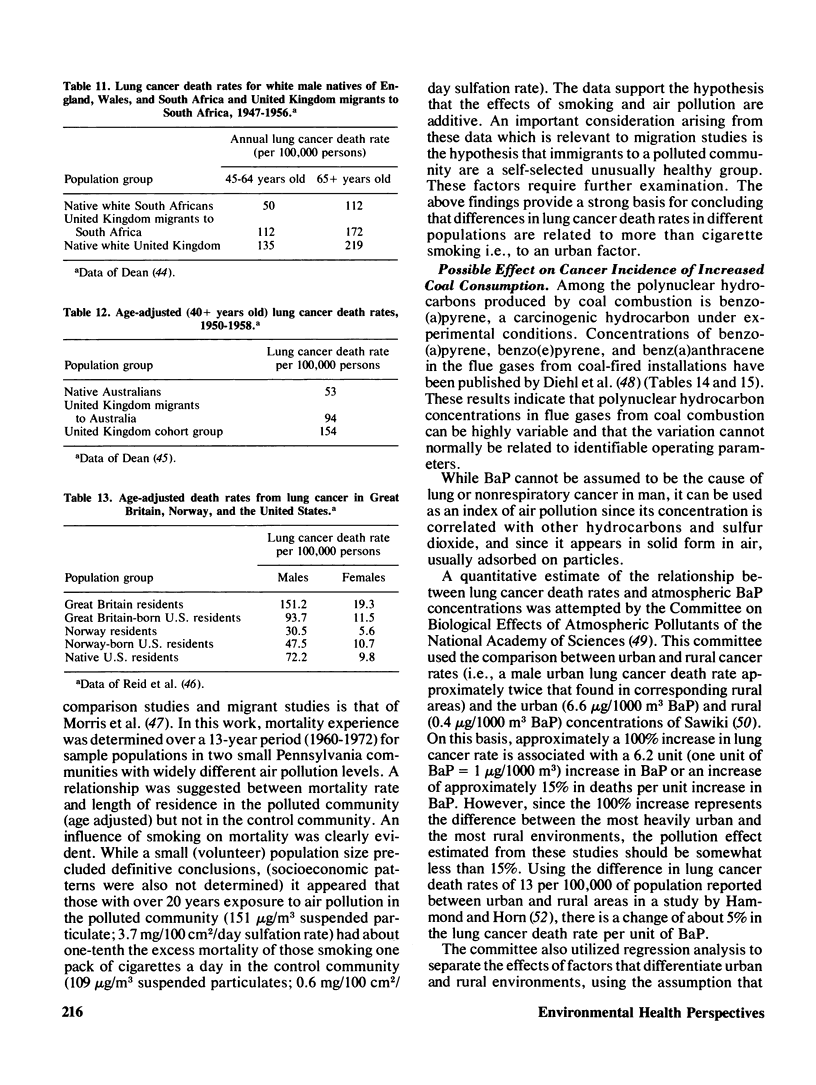
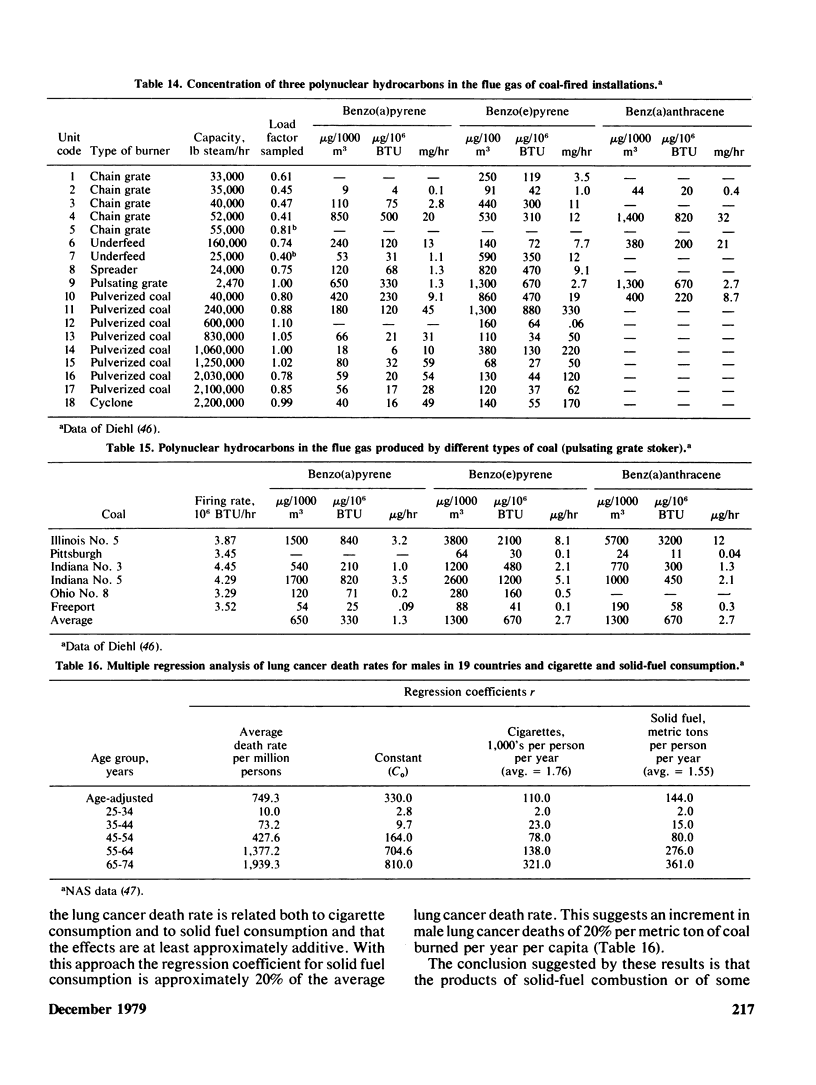
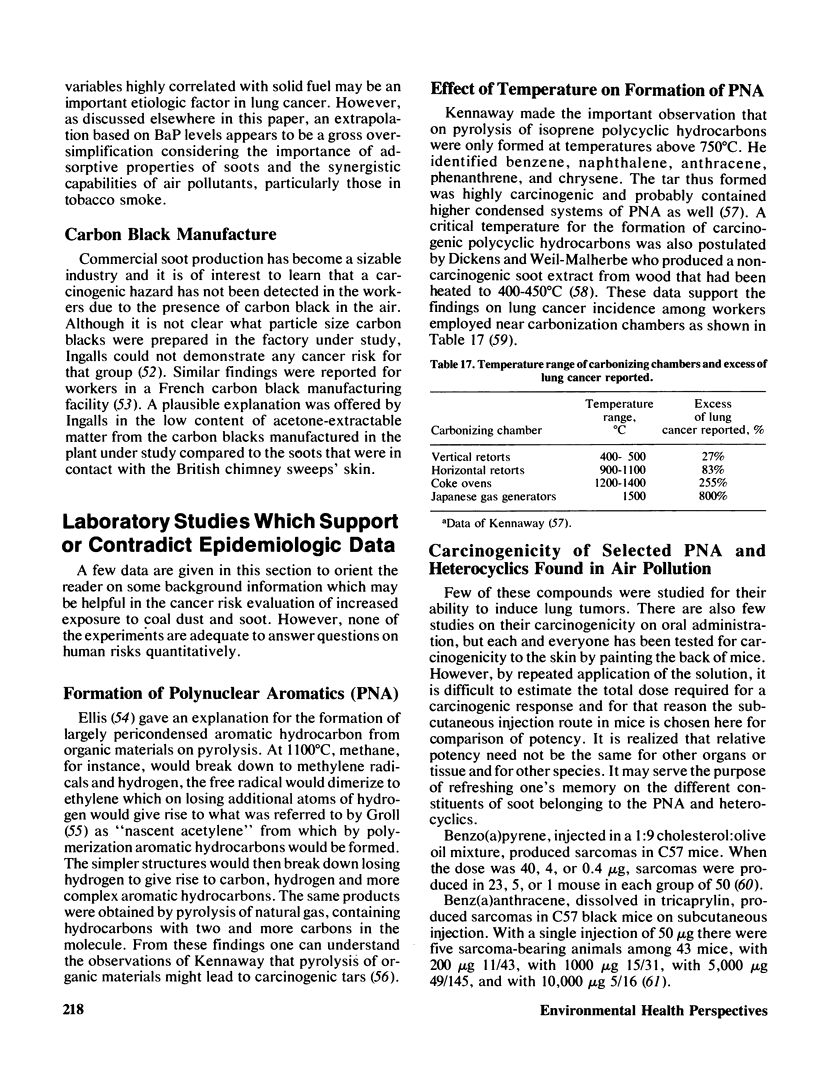
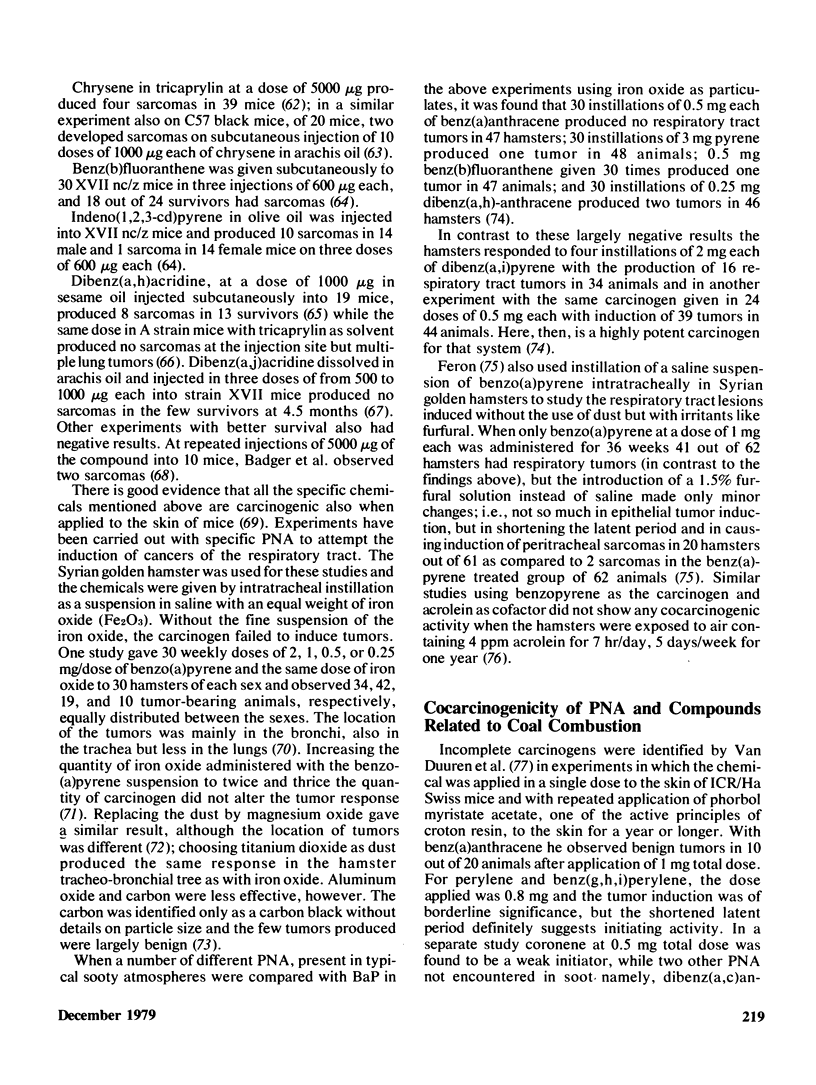
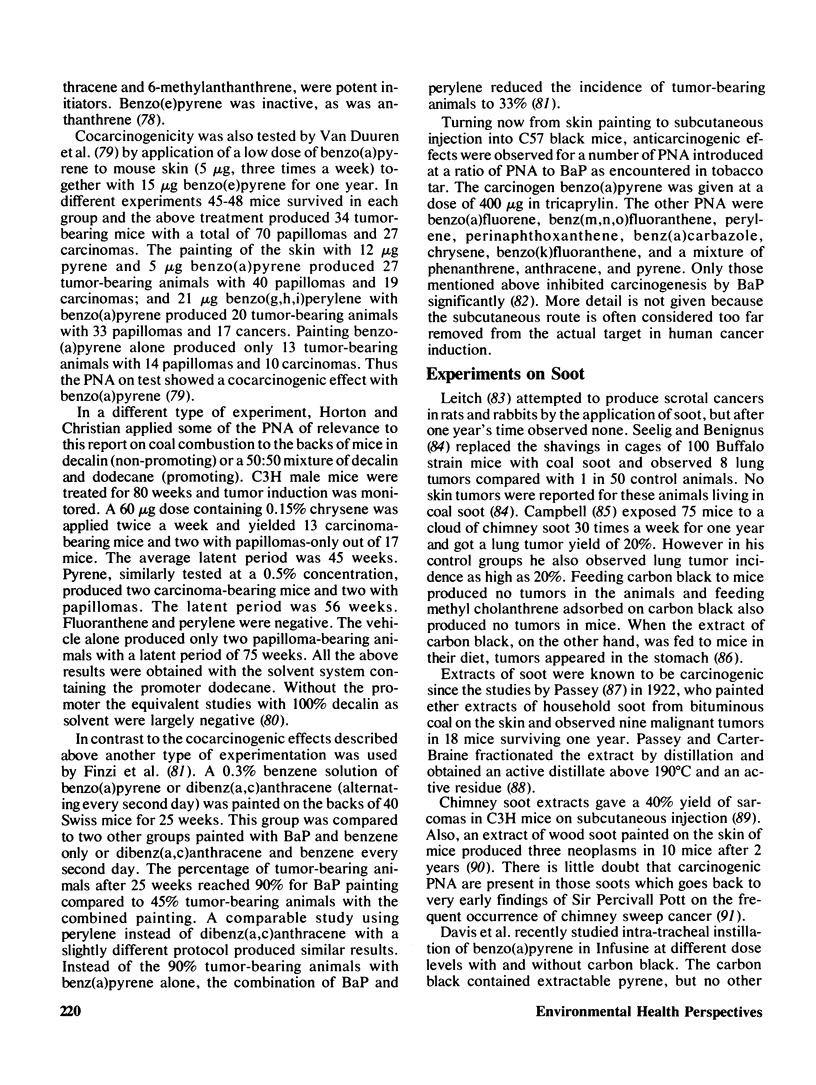
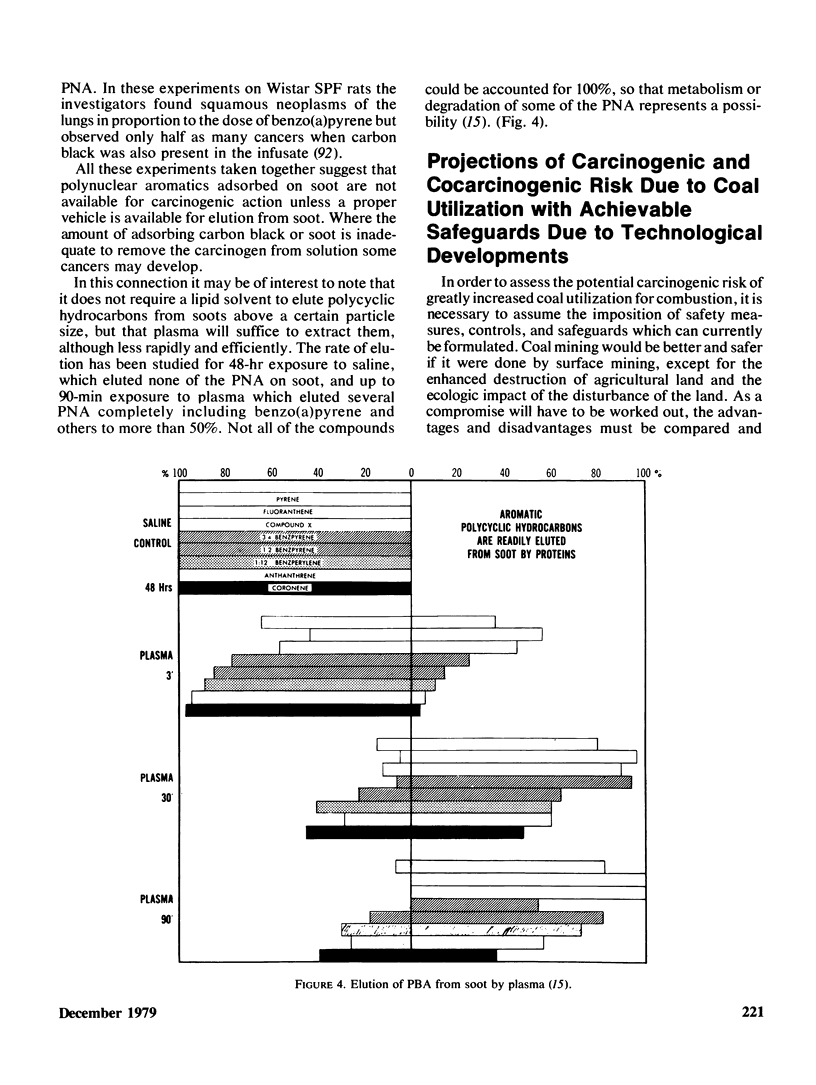
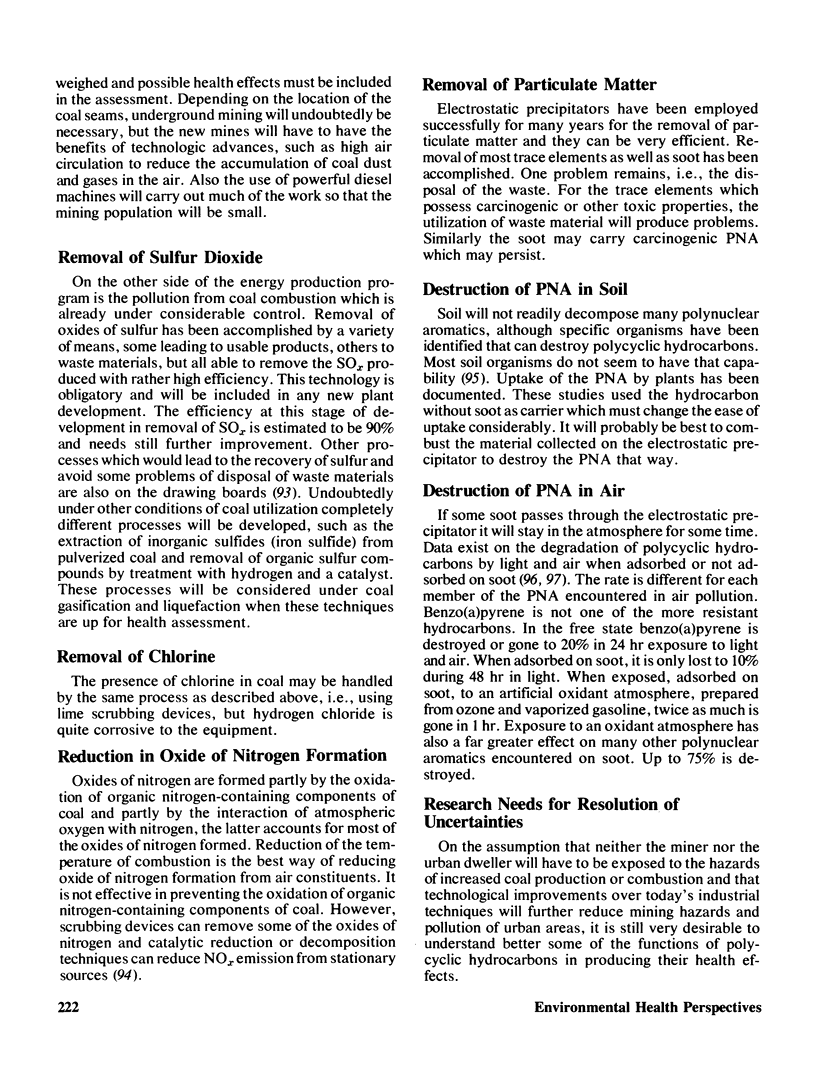
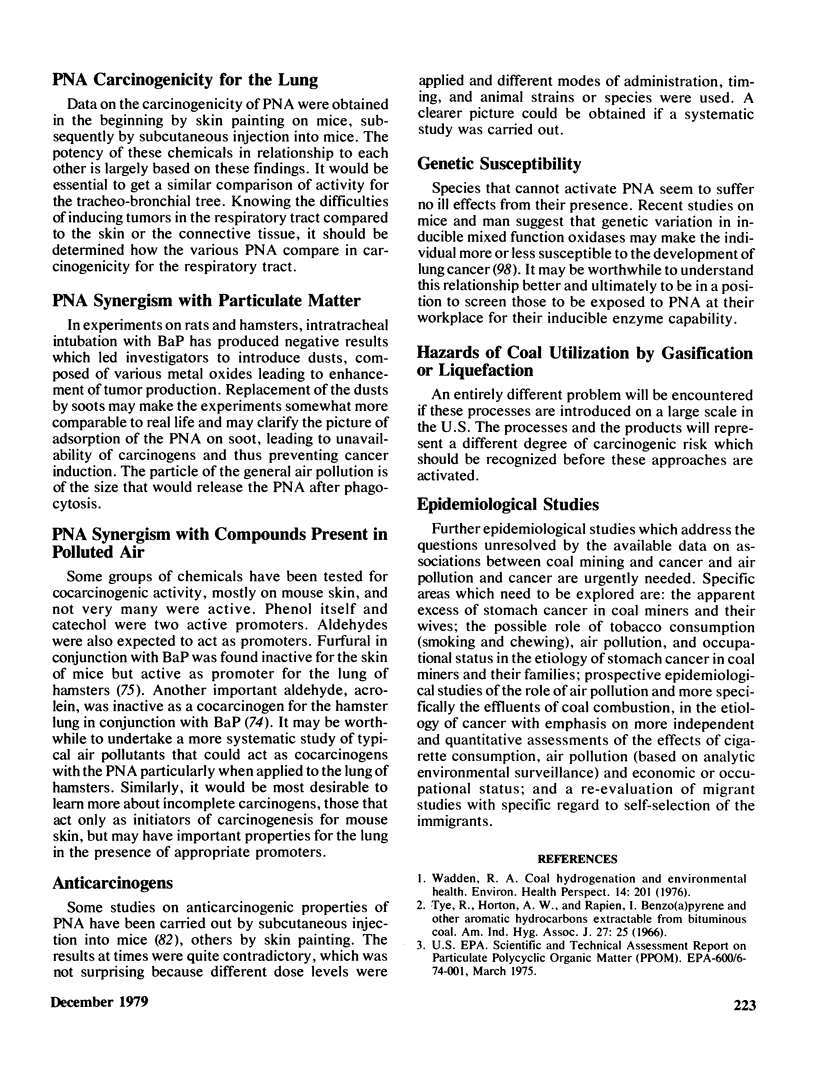
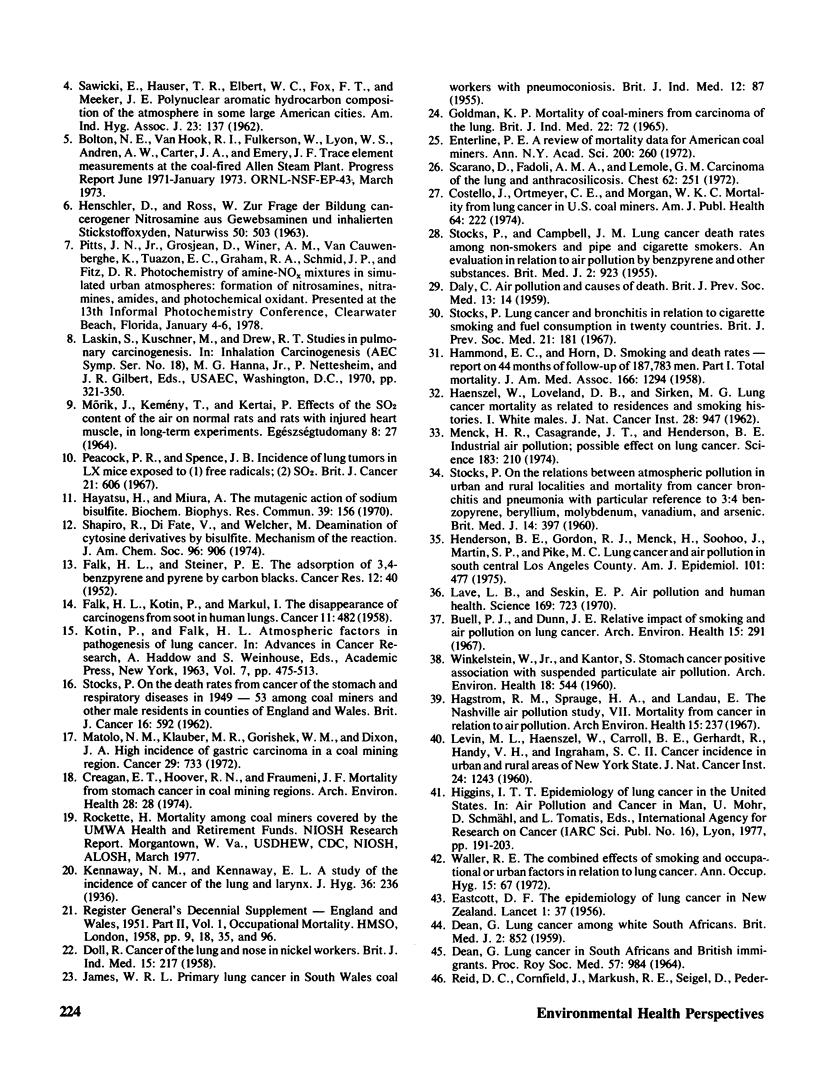
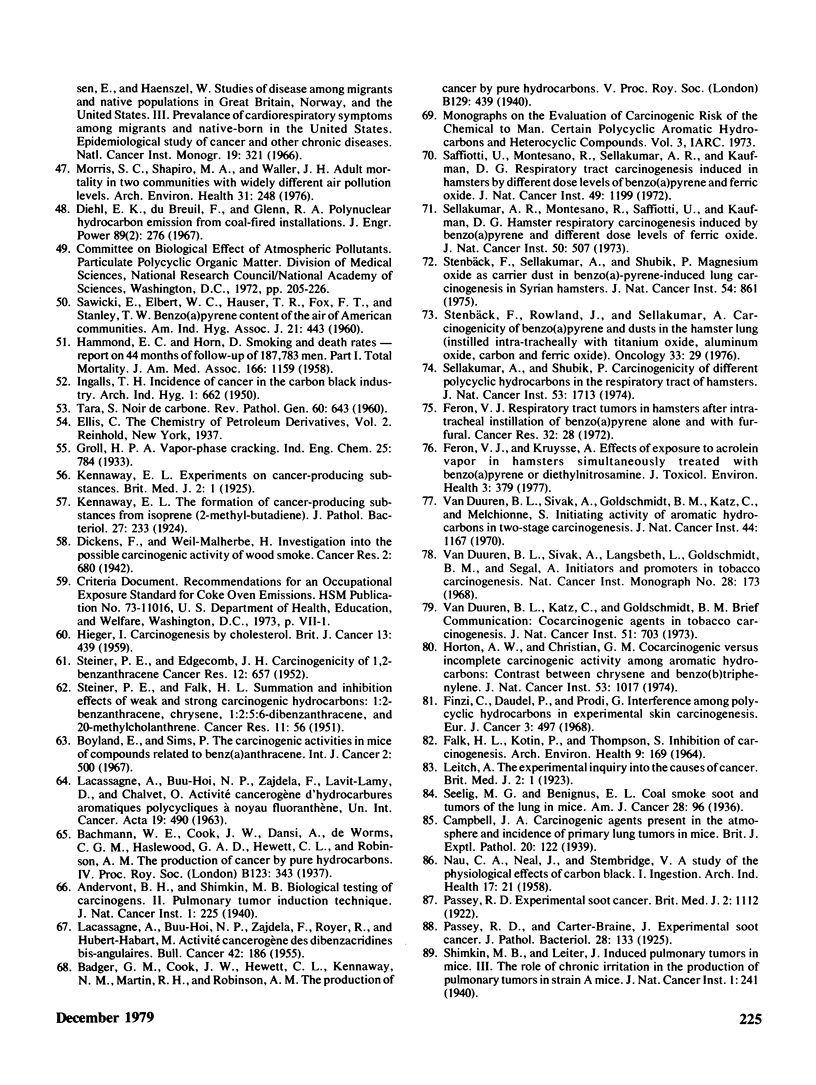
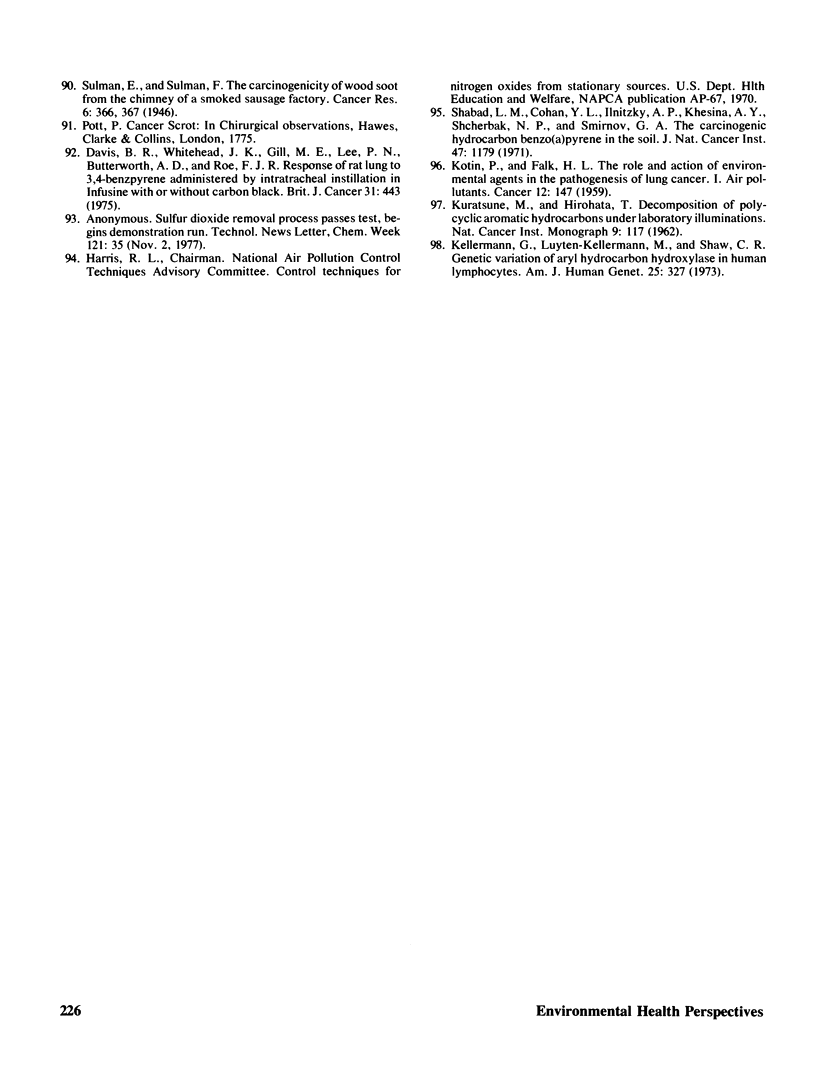
Selected References
These references are in PubMed. This may not be the complete list of references from this article.
- Boyland E., Sims P. The carcinogenic activities in mice of compounds related to benz[a]anthracene. Int J Cancer. 1967 Sep 15;2(5):500–504. doi: 10.1002/ijc.2910020511. [DOI] [PubMed] [Google Scholar]
- Buell P., Dunn J. E. Relative impact of smoking and air pollution on lung cancer. Arch Environ Health. 1967 Sep;15(3):291–297. doi: 10.1080/00039896.1967.10664920. [DOI] [PubMed] [Google Scholar]
- Costello J., Ortmeyer C. E., Morgan W. K. Mortality from lung cancer in U.S. coal miners. Am J Public Health. 1974 Mar;64(3):222–224. doi: 10.2105/ajph.64.3.222. [DOI] [PMC free article] [PubMed] [Google Scholar]
- Creagan E. T., Hoover R. N., Fraumeni J. F., Jr Mortality from stomach cancer in coal mining regions. Arch Environ Health. 1974 Jan;28(1):28–30. doi: 10.1080/00039896.1974.10666428. [DOI] [PubMed] [Google Scholar]
- DALY C. Air pollution and causes of death. Br J Prev Soc Med. 1959 Jan;13(1):14–27. doi: 10.1136/jech.13.1.14. [DOI] [PMC free article] [PubMed] [Google Scholar]
- DEAN G. LUNG CANCER IN SOUTH AFRICANS AND BRITISH IMMIGRANTS. Proc R Soc Med. 1964 Oct;57:SUPPL–SUPPL:987. [PMC free article] [PubMed] [Google Scholar]
- DEAN G. Lung cancer among white South Africans. Br Med J. 1959 Oct 31;2(5156):852–857. doi: 10.1136/bmj.2.5156.852. [DOI] [PMC free article] [PubMed] [Google Scholar]
- DOLL R. Cancer of the lung and nose in nickel workers. Br J Ind Med. 1958 Oct;15(4):217–223. doi: 10.1136/oem.15.4.217. [DOI] [PMC free article] [PubMed] [Google Scholar]
- Davis B. R., Whitehead J. K., Gill M. E., Lee P. N., Butterworth A. D., Roe F. J. Response of rat lung to 3,4-benzpyrene administered by intratracheal instillation in infusine with or without carbon black. Br J Cancer. 1975 Apr;31(4):443–452. doi: 10.1038/bjc.1975.84. [DOI] [PMC free article] [PubMed] [Google Scholar]
- EASTCOTT D. F. The epidemiology of lung cancer in New Zealand. Lancet. 1956 Jan 7;270(6906):37–39. doi: 10.1016/s0140-6736(56)91875-x. [DOI] [PubMed] [Google Scholar]
- Enterline P. E. A review of mortality data for American coal miners. Ann N Y Acad Sci. 1972 Dec 29;200:260–272. doi: 10.1111/j.1749-6632.1972.tb40192.x. [DOI] [PubMed] [Google Scholar]
- FALK H. L., KOTIN P., MARKUL I. The disappearance of carcinogens from soot in human lungs. Cancer. 1958 May-Jun;11(3):482–489. doi: 10.1002/1097-0142(195805/06)11:3<482::aid-cncr2820110308>3.0.co;2-v. [DOI] [PubMed] [Google Scholar]
- FALK H. L., KOTIN P., THOMPSON S. INHIBITION OF CARCINOGENESIS. THE EFFECT OF HYDROCARBONS AND RELATED COMPOUNDS. Arch Environ Health. 1964 Aug;9:169–179. doi: 10.1080/00039896.1964.10663816. [DOI] [PubMed] [Google Scholar]
- FALK H. L., STEINER P. E. The adsorption of 3,4-benzpyrene and pyrene by carbon blacks. Cancer Res. 1952 Jan;12(1):40–43. [PubMed] [Google Scholar]
- Feron V. J., Kruysse A. Effects of exposure to acrolein vapor in hamsters simultaneously treated with benzo[a]pyrene or diethylnitrosamine. J Toxicol Environ Health. 1977 Oct;3(3):379–394. doi: 10.1080/15287397709529571. [DOI] [PubMed] [Google Scholar]
- Feron V. J. Respiratory tract tumors in hamsters after intratracheal instillations of benzo(a)pyrene alone and with furfural. Cancer Res. 1972 Jan;32(1):28–36. [PubMed] [Google Scholar]
- Finzi C., Daudel P., Prodi G. Interference among polycyclic hydrocarbons in experimental skin carcinogenesis. Eur J Cancer. 1968 Jan;3(6):497–501. doi: 10.1016/0014-2964(68)90087-x. [DOI] [PubMed] [Google Scholar]
- GOLDMAN K. P. MORTALITY OF COAL-MINERS FROM CARCINOMA OF THE LUNG. Br J Ind Med. 1965 Jan;22:72–77. doi: 10.1136/oem.22.1.72. [DOI] [PMC free article] [PubMed] [Google Scholar]
- HAENSZEL W., LOVELAND D. B., SIRKEN M. G. Lung-cancer mortality as related to residence and smoking histories. I. White males. J Natl Cancer Inst. 1962 Apr;28:947–1001. [PubMed] [Google Scholar]
- HAMMOND E. C., HORN D. Smoking and death rates; report on forty-four months of follow-up of 187,783 men. I. Total mortality. J Am Med Assoc. 1958 Mar 8;166(10):1159–1172. doi: 10.1001/jama.1958.02990100047009. [DOI] [PubMed] [Google Scholar]
- HIEGER I. Carcinogenesis by cholesterol. Br J Cancer. 1959 Sep;13:439–451. doi: 10.1038/bjc.1959.49. [DOI] [PMC free article] [PubMed] [Google Scholar]
- Hagstrom R. M., Sprague H. A., Landau E. The Nashville Air Pollution Study. VII. Mortality from cancer in relation to air pollution. Arch Environ Health. 1967 Aug;15(2):237–248. doi: 10.1080/00039896.1967.10664907. [DOI] [PubMed] [Google Scholar]
- Hayatsu H., Miura A. The mutagenic action of sodium bisulfite. Biochem Biophys Res Commun. 1970 Apr 8;39(1):156–160. doi: 10.1016/0006-291x(70)90771-0. [DOI] [PubMed] [Google Scholar]
- Henderson B. E., Gordon R. J., Menck H., Soohoo J., Martin S. P., Pike M. C. Lung cancer and air pollution in southcentral Los Angeles County. Am J Epidemiol. 1975 Jun;101(6):477–488. doi: 10.1093/oxfordjournals.aje.a112118. [DOI] [PubMed] [Google Scholar]
- Horton A. W., Christian G. M. Cocarcinogenic versus incomplete carcinogenic activity among aromatic hydrocarbons: contrast between chrysene and benzo(b)triphenylene. J Natl Cancer Inst. 1974 Oct;53(4):1017–1020. doi: 10.1093/jnci/53.4.1017. [DOI] [PubMed] [Google Scholar]
- INGALLS T. H. Incidence of cancer in the carbon black industry. Arch Ind Hyg Occup Med. 1950 Jun;1(6):662–676. [PubMed] [Google Scholar]
- JAMES W. R. Primary lung cancer in South Wales coal-workers with pneumoconiosis. Br J Ind Med. 1955 Apr;12(2):87–91. doi: 10.1136/oem.12.2.87. [DOI] [PMC free article] [PubMed] [Google Scholar]
- KOTIN P., FALK H. L. ATMOSPHERIC FACTORS IN PATHOGENESIS OF LUNG CANCER. Adv Cancer Res. 1963;7:475–514. doi: 10.1016/s0065-230x(08)60987-2. [DOI] [PubMed] [Google Scholar]
- KOTIN P., FALK H. L. The role and action of environmental agents in the pathogenesis of hung cancer. I. Air pollutants. Cancer. 1959 Jan-Feb;12(1):147–163. doi: 10.1002/1097-0142(195901/02)12:1<147::aid-cncr2820120121>3.0.co;2-u. [DOI] [PubMed] [Google Scholar]
- KURATSUNE M., HIROHATA T. Decomposition of polycyclic aromatic hydrocarbons under laboratory illuminations. Natl Cancer Inst Monogr. 1962 Aug;9:117–125. [PubMed] [Google Scholar]
- Kellermann G., Luyten-Kellermann M., Shaw C. R. Genetic variation of aryl hydrocarbon hydroxylase in human lymphocytes. Am J Hum Genet. 1973 May;25(3):327–331. [PMC free article] [PubMed] [Google Scholar]
- LACASSAGNE A., BUU-HOI N. P., ZAJDELA F., LAVIT-LAMY D., CHALVET O. ACTIVITE CANC'EROG'ENE D'HYDROCARBURES AROMATIQUES POLYCYCLIQUES A NOYAU FLUORANTHENE. Acta Unio Int Contra Cancrum. 1963;19:490–496. [PubMed] [Google Scholar]
- LACASSAGNE A., BUU-HOI N. P., ZAJDELA F., ROYER R., HUBERT-HABART M. Activité cancérogène des dibenzacridines bisangulaires. Bull Assoc Fr Etud Cancer. 1955;42(2):186–191. [PubMed] [Google Scholar]
- LEVIN M. L., HAENSZEL W., CARROLL B. E., GERHARDT P. R., HANDY V. H., INGRAHAM S. C., 2nd Cancer incidence in urban and rurl areas of New York State. J Natl Cancer Inst. 1960 Jun;24:1243–1257. [PubMed] [Google Scholar]
- Lave L. B., Seskin E. P. Air pollution and human health. Science. 1970 Aug 21;169(3947):723–733. doi: 10.1126/science.169.3947.723. [DOI] [PubMed] [Google Scholar]
- Matolo N. M., Klauber M. R., Gorishek W. M., Dixon J. A. High incidence of gastric carcinoma in a coal mining region. Cancer. 1972 Mar;29(3):733–737. doi: 10.1002/1097-0142(197203)29:3<733::aid-cncr2820290329>3.0.co;2-4. [DOI] [PubMed] [Google Scholar]
- Menck H. R., Casagrande J. T., Henderson B. E. Industrial air pollution: possible effect on lung cancer. Science. 1974 Jan 18;183(4121):210–212. doi: 10.1126/science.183.4121.210. [DOI] [PubMed] [Google Scholar]
- Morris S. C., Shapiro M. A., Waller J. H. Adult mortality in two communities with widely different air pollution levels. Arch Environ Health. 1976 Sep-Oct;31(5):248–254. doi: 10.1080/00039896.1976.10667228. [DOI] [PubMed] [Google Scholar]
- NAU C. A., NEAL J., STEMBRIDGE V. A study of the physiological effects of carbon black. I. Ingestion. AMA Arch Ind Health. 1958 Jan;17(1):21–28. [PubMed] [Google Scholar]
- Peacock P. R., Spence J. B. Incidence of lung tumours in LX mice exposed to (1) free radicals; (2) SO2. Br J Cancer. 1967 Sep;21(3):606–618. doi: 10.1038/bjc.1967.71. [DOI] [PMC free article] [PubMed] [Google Scholar]
- Reid D. D., Cornfield J., Markush R. E., Seigel D., Pedersen E., Haenszel W. Studies of disease among migrants and native populations in Great Britain, Norway, and the United States. 3. Prevalence of cardiorespiratory symptoms among migrants and native-born in the United States. Natl Cancer Inst Monogr. 1966 Jan;19:321–346. [PubMed] [Google Scholar]
- SAWICKI E., ELBERT W. C., HAUSER T. R., FOX F. T., STANLEY T. W. Benzo(a)pyrene content of the air of American communities. Am Ind Hyg Assoc J. 1960 Dec;21:443–451. doi: 10.1080/00028896009344103. [DOI] [PubMed] [Google Scholar]
- SAWICKI E., HAUSER T. R., ELBERT W. C., FOX F. T., MEEKER J. E. Polynuclear aromatic hydrocarbon composition of the atmosphere in some large American cities. Am Ind Hyg Assoc J. 1962 Mar-Apr;23:137–144. doi: 10.1080/00028896209343216. [DOI] [PubMed] [Google Scholar]
- STEINER P. E., EDGCOMB J. H. Carcinogenicity of 1, 2-benzanthracene. Cancer Res. 1952 Sep;12(9):657–659. [PubMed] [Google Scholar]
- STEINER P. E., FALK H. L. Summation and inhibition effects of weak and strong carcinogenic hydrocarbons: 1:2-benzanthracene, chrysene, 1:2:5:6-dibenzanthracene, and 20-methylcholanthrene. Cancer Res. 1951 Jan;11(1):56–63. [PubMed] [Google Scholar]
- STOCKS P., CAMPBELL J. M. Lung cancer death rates among non-smokers and pipe and cigarette smokers; an evaluation in relation to air pollution by benzpyrene and other substances. Br Med J. 1955 Oct 15;2(4945):923–929. doi: 10.1136/bmj.2.4945.923. [DOI] [PMC free article] [PubMed] [Google Scholar]
- STOCKS P. On the death rates from cancer of the stomach and respiratory diseases in 1949-53 among coal miners and other male residents in counties of England and Wales. Br J Cancer. 1962 Dec;16:592–598. doi: 10.1038/bjc.1962.69. [DOI] [PMC free article] [PubMed] [Google Scholar]
- Saffiotti U., Montesano R., Sellakumar A. R., Kaufman D. G. Respiratory tract carcinogenesis induced in hamsters by different dose levels of benzo-(a)pyrene and ferric oxide. J Natl Cancer Inst. 1972 Oct;49(4):1199–1204. [PubMed] [Google Scholar]
- Scarano D., Fadali A. M., Lemole G. M. Carcinoma of the lung and anthracosilicosis. Chest. 1972 Sep;62(3):251–254. doi: 10.1378/chest.62.3.251. [DOI] [PubMed] [Google Scholar]
- Sellakumar A. R., Montesano R., Saffiotti U., Kaufman D. G. Hamster respiratory carcinogenesis induced by benzo(a)pyrene and different dose levels of ferric oxide. J Natl Cancer Inst. 1973 Feb;50(2):507–510. doi: 10.1093/jnci/50.2.507. [DOI] [PubMed] [Google Scholar]
- Sellakumar A., Shubik P. Carcinogenicity of different polycyclic hydrocarbons in the respiratory tract of hamsters. J Natl Cancer Inst. 1974 Dec;53(6):1713–1719. [PubMed] [Google Scholar]
- Shabad L. M., Cohan Y. L., Ilnitsky A. P., Khesina A. Y., Shcherbak N. P., Smirnov G. A. The carcinogenic hydrocarbon benzo[a]pyrene in the soil. J Natl Cancer Inst. 1971 Dec;47(6):1179–1191. [PubMed] [Google Scholar]
- Shapiro R., DiFate V., Welcher M. Deamination of cytosine derivatives by bisulfite. Mechanism of the reaction. J Am Chem Soc. 1974 Feb 6;96(3):906–912. doi: 10.1021/ja00810a043. [DOI] [PubMed] [Google Scholar]
- Stenbäck F., Sellakumar A., Shubik P. Magnesium oxide as carrier dust in benzo(a)pyrene-induced lung carcino-genesis in Syrian hamsters. J Natl Cancer Inst. 1975 Apr;54(4):861–867. [PubMed] [Google Scholar]
- TARA S. [Carbon black]. Rev Pathol Gen Physiol Clin. 1960 May;60:643–679. [PubMed] [Google Scholar]
- Van Duuren B. L., Katz C., Goldschmidt B. M. Cocarcinogenic agents in tobacco carcinogenesis. J Natl Cancer Inst. 1973 Aug;51(2):703–705. [PubMed] [Google Scholar]
- Van Duuren B. L., Sivak A., Goldschmidt B. M., Katz C., Melchionne S. Initiating activity of aromatic hydrocarbons in two-stage carcinogenesis. J Natl Cancer Inst. 1970 May;44(5):1167–1173. [PubMed] [Google Scholar]
- Van Duuren B. L., Sivak A., Langseth L., Goldschmidt B. M., Segal A. Initiators and promoters in tobacco carcinogenesis. Natl Cancer Inst Monogr. 1968 Jun;28:173–180. [PubMed] [Google Scholar]
- Wadden R. A. Coal hydrogenation and environmental health. Environ Health Perspect. 1976 Apr;14:201–206. doi: 10.1289/ehp.7614201. [DOI] [PMC free article] [PubMed] [Google Scholar]
- Waller R. E. The combined effects of smoking and occupational or urban factors in relation to lung cancer. Ann Occup Hyg. 1972 Apr;15(1):67–73. doi: 10.1093/annhyg/15.1.67. [DOI] [PubMed] [Google Scholar]
- Winkelstein W., Jr, Kantor S. Stomach cancer. Positive association with suspended particulate air pollution. Arch Environ Health. 1969 Apr;18(4):544–547. doi: 10.1080/00039896.1969.10665450. [DOI] [PubMed] [Google Scholar]


